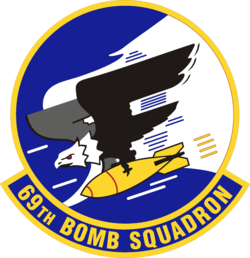69th Bombardment Squadron
| 69th Bomb Squadron | |
|---|---|

Emblem of the 69th Bombardment Squadron
|
|
| Active | 1940–1991 2009-present |
| Country | United States |
| Branch | United States Air Force |
| Type | Squadron |
| Role | Bombardment |
| Part of |
5th Bomb Wing Eighth Air Force Air Force Global Strike Command |
| Garrison/HQ | Minot Air Force Base |
| Nickname(s) | Knighthawks |
| Colors | Gray/yellow |
The 69th Bomb Squadron is an active United States Air Force unit. After being inactivated on 1 September 1991, it was reactivated on 3 September 2009 at Minot Air Force Base, and assigned to the 5th Bomb Wing. The squadron operates B-52H aircraft.
Established as a pre-World War II GHQAF bombardment squadron; equipped with B-18 Bolos and early-model B-26 Marauders. After the Japanese Attack on Pearl Harbor, squadron was engaged in antisubmarine operations over the mid-Atlantic coast. Reassigned to Third Air Force and equipped with A-26 Invader light bombers; deployed to Fifth Air Force in Australia in 1942 as part of the re-equipping of that command after its withdraw to Australia after the 1941-1942 Battle of the Philippines.
Deployed to South Pacific Area (SPA); being assigned to Thirteenth Air Force and attacking enemy targets in the Solomon Islands; New Hebrides and other enemy locations north and east of Papua New Guinea. Became part of Mac Arthur's New Guinea campaign, supported Army ground forces with tactical bombing of enemy formations and targets along the northern coast of New Guinea and in the Dutch East Indies.
Attacked enemy forces in the Philippines during early 1945 as part of the liberation from Japanese control; continued combat missions until the Japanese capitulation in August 1945. Became part of the Fifth Air Force forces in Occupied Japan in 1946 before being demobilized and inactivated in May 1946.
The 69th was awarded a Distinguished Unit Citation for its pre-invasion bombing of Balikpapan between 23 and 30 June 1945. Balikpapan was a center for oil refining on Borneo held by the Japanese. These attacks included bombing and strafing enemy shore installations. The round trip to the target was over 1700 miles and was among the longest flown by medium bombers during the war. Pre mission experiments determined that the squadron's bombers could carry a bomb load over this distance with fuel tanks installed in their radio compartments despite having to take off from a runway damaged by enemy action. Four of the missions encountered severe tropical weather fronts. Despite intense and accurate flak, the squadron destroyed gun positions, warehouses, roadblocks, fuel and ammunition dumps, a radar station as well as huge stores of gasoline and oil which the enemy had placed in position to be released into shallow pits oil the beach and ignited when the Australian ground troops made their assaults. The group attacked the beach while naval underwater demolition teams operated offshore without losing a man. The attacks were so effective that the Australian Seventh Division was able to come ashore without enemy opposition.
...
Wikipedia
